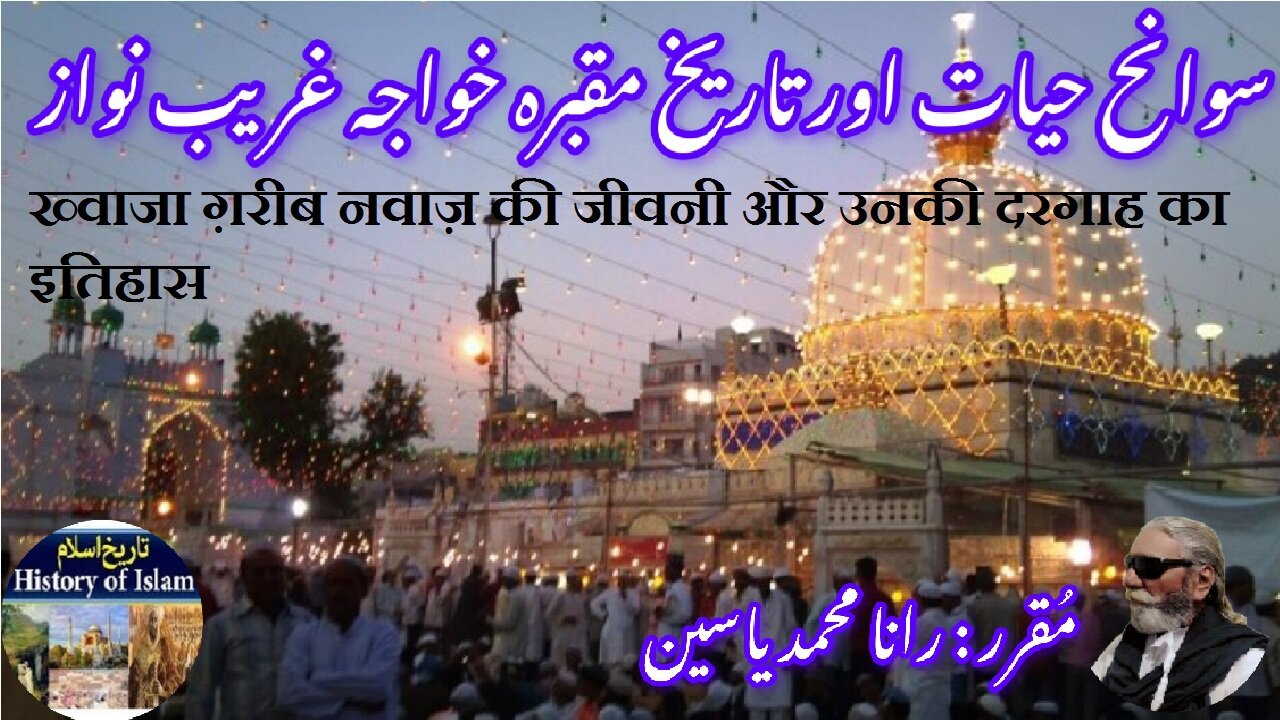Premium Only Content

Khawaja Gharib Nawaz | ख्वाजा गरीब नवाज | خواجہ غریب نواز کی سوانح عمری اور ان کے مزار کی تاریخ
@islamichistory813 #khawajagharibnawaz #muinaldinchishti #sufisaint #culturalheritage #biography #islamicmysticism #islamicphilosophy #shrine #historicalfigures #ajmir
Biography of Khawaja Gharib Nawaz and the history of his shrine
Dekhti Aankhooon aur sountay kaanoon ko Asslamoalaikum, sisters, brothers friends and elders, in informative series videos of Islamic ascolars, sufisaints, cultural heritages, islamic philosophys, islamic mysticisms and historical figures. today we are describing biography of Khawaja Gharib Nawaz and the history of his shrine.
Muin al-Din Hasan Chishti Sijzi Muin al-Din Chishti known reverentially as Khawaja Gharib Nawaz, was a Persian Islamic scholar and mystic from Sistan, who eventually ended up settling in the Indian subcontinent in the early 13th-century, where he promulgated the Chishtiyya order of Sunni mysticism. This particular Tariqa (order) became the dominant Islamic spiritual order in medieval India. Most of the Indian Sunni saints are Chishti in their affiliation, including Nizamuddin Awliya and Amir Khusrow.
Having arrived in Delhi Sultanate during the reign of the sultan Iltutmish, Mu??n al-D?n moved from Delhi to Ajmer shortly thereafter, at which point he became increasingly influenced by the writings of the Sunni Hanbali scholar and mystic ?Abdallah An?ari, whose work on the lives of the early Islamic saints, the ?abaqat al-?ufiyya, may have played a role in shaping Muin al-Din's worldview. It was during his time in Ajmer that Muin al-D?n acquired the reputation of being a charismatic and compassionate spiritual preacher and teacher; and biographical accounts of his life written after his death report that he received the gifts of many "spiritual marvels (karamat), such as miraculous travel, clairvoyance, and visions of angels" in these years of his life. Mu??n al-Din seems to have been unanimously regarded as a great saint after his death.
Muin al-Din Chishtiis legacy rests primarily on his having been "one of the most outstanding figures in the annals of Islamic mysticism. Additionally, Muin al-Din Chishti is also notable, according to John Esposito, for having been one of the first major Islamic mystics to formally allow his followers to incorporate the "use of music" in their devotions, liturgies, and hymns to God, which he did in order to make the 'foreign' Arab faith more relatable to the indigenous peoples who had recently entered the religion.
Of Persian descent, Muin al-Din Chishti was born in 1143 in Sistan. He was sixteen years old when his father, Sayyid Ghiyath al-Din, died, leaving his grinding mill and orchard to his son.
Despite planning to continue his father's business, he developed mystic tendencies in his personal piety [clarification needed] and soon entered a life of destitute itineracy. He enrolled at the seminaries of Bukhara and Samarkand, and (probably) visited the shrines of Muhammad al-Bukhari and Abu Mansur al-Maturidi , two widely venerated figures in the Islamic world.
While traveling to Iran, in the district of Nishapur, he came across the Sunni mystic khwaja ?Uthman, who initiated him. Accompanying his spiritual guide for over twenty years on the latter's journeys from region to region, Mu??n al-D?n also continued his own independent spiritual travels during the time period. It was on his independent wanderings that Mu??n al-D?n encountered many of the most notable Sunni mystics of the era, including Abdul-Qadir Gilani and Najmuddin Kubra (d. 1221), as well as Najib al-Din ?Abd al-?ahir Suhraward?, Ab? Sa??d Tabr?z?, and ?Abd al-Wa?id Ghaznawi , all of whom were destined to become some of the most highly venerated saints in the Sunni tradition.
Arriving in South Asia in the early thirteenth century along with his cousin and spiritual successor Khwaja Syed Fakhr Al-Din Gardezi Chishti, Muin al-Din first travelled to Lahore to meditate at the tomb-shrine of the Sunni mystic and jurist Ali Hujwiri (d. 1072).
From Lahore, he continued towards Ajmer, where he settled and married the daughter of Saiyad Wajiuddin, whom he married in the year 1209/10. He went on to have three sons—Abu Said, Fak?h?r al-D?n and ?usam al-Din — and one daughter, Bibi Jamal. After settling in Ajmer, Muin al-Din strove to establish the Chishti order of Sunni mysticism in India; many later biographic accounts relate the numerous miracles wrought by God at the hands of the saint during this period.
Muin al-Din Chishti was not the originator or founder of the Chishtiyya order of mysticism as he is often erroneously thought to be. On the contrary, the Chishtiyya was already an established Sufi order prior to his birth, being originally an offshoot of the older Adhamiyya order that traced its spiritual lineage and titular name to the early Islamic saint and mystic Ibrahim ibn Adham. Thus, this particular branch of the Adhamiyya was renamed the Chishtiyya after the 10th-century Sunni mystic Abu Is?aq al-Shami migrated to Chishti Sharif, a town in the present day Herat Province of Afghanistan in around 930, in order to preach Islam in that area about 148 years prior to the birth of the founder of the Qadiriyya sufi order, Shaikh Abdul Qadir Gilani. The order spread into the Indian subcontinent, however, at the hands of the Persian Mu??n al-D?n in the 13th-century, after the saint is believed to have had a dream in which the Islamic prophet Muhammad appeared and told him to be his "representative" or "envoy" in India.
According to the various chronicles, Muin al-Din's tolerant and compassionate behavior towards the local population seems to have been one of the major reasons behind conversion to Islam at his hand. Muin al-Din Chishti is said to have appointed Bakhtiar Kaki as his spiritual successor, who worked at spreading the Chishtiyya in Delhi. Furthermore, Muin al-Din's son, Fakhr al-Din, is said to have further spread the order's teachings in Ajmer, whilst another of the saint's major disciples, ?amid al-Din ?ufi Nagawri, preached in Nagaur, Rajasthan.
The tomb (dargah) of Muin al-Din became a deeply venerated site in the century following the preacher's death in March 1236. Honoured by members of all social classes, the tomb was treated with great respect by many of the era's most important Sunni rulers, including Muhammad bin Tughluq, the Sultan of Delhi from 1324 to 1351, who visited the tomb in 1332 to commemorate the memory of the saint. In a similar way, the later Mughal emperor Akbar visited the shrine no less than fourteen times during his reign.
In the present day, the tomb of Muin al-Din continues to be one of the most popular sites of religious visitation for Sunni Muslims in the Indian subcontinent, with over "hundreds of thousands of people from all over the Indian sub-continent assembling there on the occasion of [the saint's] ?urs or death anniversary." Additionally, the site also attracts many Hindus, who have also venerated the Islamic saint since the medieval period. A bomb planted was planted on 11 October 2007 in the Dargah of Sufi Saint Khawaja Moinuddin Chishti at the time of Iftar had left three pilgrims dead and 15 injured. A special National Investigation Agency (NIA) court in Jaipur punished with life imprisonment the two convicts in the 2007 Ajmer Dargah bomb blast case.
Indian films about the saint and his dargah at Ajmer include Mere Gharib Nawaz by G. Ishwar, Sultan E Hind (1973) by K. Sharif, Khawaja Ki Diwani (1981) by Akbar Balam and Mere Data Garib Nawaz (1994) by M Gulzar Sultani. A song in the 2008 Indian film Jodhaa Akbar named "Khwaja Mere Khwaja", composed by A. R. Rahman, pays tribute to Muin al-Din Chishti.
Various qawwalis portray devotion to the saint including Nusrat Fateh Ali Khan's "Khwaja E Khwajgan", Sabri Brothers' "Khawaja Ki Deewani"and Koji Badayuni's "Kabhi rab se Mila Diya"
With this, we seek your permission until tomorrow, tomorrow we will describe the biography of Al-Hakim al-Tirmidhi and the history of his Shrine.
================
-
 13:26
13:26
ISLAMIC HISTORY
20 hours agoIslamic History Episode 241 The Dethronement and Death of Mu'taz Billah معتز بلہ کی معزولی اور وفات
61 -
 24:38
24:38
Professor Nez
17 hours agoTrump Just SHOOK the Democrats to the CORE with THIS MOVE!
73010 -
 14:16
14:16
Actual Justice Warrior
3 days agoManhattan DA Says It's Okay To ATTACK Pro Life Activists
11.7K29 -
 5:31
5:31
Buddy Brown
1 day ago $0.95 earnedJames Comey Forgot This Video EXISTS! | Buddy Brown
24.4K11 -
 20:47
20:47
James Klüg
1 day agoAsking Democrats What Ended The Border Crisis Vol. 3
21.8K30 -
 18:09
18:09
Forrest Galante
1 day agoI Survived 24 Hours In The World's Deadliest Jungle
165K21 -
 15:23
15:23
GritsGG
15 hours agoBad Start Leads to Ultimate Warzone Victory w/ Bobby Poff!
8.33K1 -
 2:03:56
2:03:56
Side Scrollers Podcast
19 hours agoSmash Pro DEMANDS “Woke Echo Chamber” + EA SOLD To Saudis + More | Side Scrollers
54K9 -
 2:15:06
2:15:06
The HotSeat
15 hours agoSame Ole Left + What the Hell is a "BAD BUNNY"
17.4K12 -
 8:11
8:11
MattMorseTV
2 days ago $24.12 earnedTrump's DECLARATION of WAR.
68.2K120